When the forecast dips toward freezing, a single cold night can undo months of work in your garden. Plant covers for freeze protection are one of the simplest ways to keep tender plants alive through cold snaps and extend your growing season.
This guide walks through how plant covers work, when to use them, how to choose the right type and size, and how to get the most protection on icy nights.
Also, check out the top-ranking plant covers on Amazon.
What Do Plant Covers Actually Do?
On a cold night, plants get damaged in two main ways:
-
Air temperature drops below what the plant tissue can tolerate
-
Frost forms on leaves and stems and damages cells in the process
Plant covers help in three key ways:
-
Trap radiant heat from the soil
-
During the day, soil absorbs heat
-
At night, a cover that reaches the ground traps some of this heat, creating a slightly warmer pocket of air around the plant.
-
-
Block cold wind
-
Wind strips away the thin layer of warmer air that surrounds leaves
-
Covers reduce wind chill and prevent rapid temperature drops around the foliage
-
-
Reduce frost formation on leaves
-
If you keep the air just a few degrees above freezing, frost is less likely to form at all
-
Most good frost cloths can give roughly 2 to 4 degrees Celsius of protection, sometimes more, depending on thickness, how well they are sealed, and how much heat the soil has stored during the day. Many extension sources cite 4 to 8 degrees Fahrenheit of protection for medium-weight frost cloths made from polypropylene or polyester fabric.
When Should You Cover Plants?
Gardeners often use simple rules to decide when to cover plants.
-
Many sources recommend protecting frost-tender plants when temperatures are forecast to be around 0 to 1 °C or lower. Some experts suggest taking action already when the forecast hits 4 °C because sensitive plants can be damaged even a little above freezing.
-
Most plants will need protection once temperatures hit about minus 2 °C or 30 °F, especially young seedlings, annuals, and warm season vegetables.
A simple rule of thumb:
-
Tender plants: cover when the forecast is 4 °C or lower
-
Half-hardy plants: cover when the forecast is around 0 °C
-
Very hardy perennials and many shrubs: often fine through light frost, but protect if a hard freeze is coming or plants are young or recently planted
Always check the specific cold tolerance for your plant types and your climate zone.
Best Materials for Plant Covers
Not all covers are created equal. The material matters a lot.
Breathable frost cloth and row covers
The gold standard for freeze protection is lightweight, breathable fabric such as polypropylene or polyester frost cloth. These are sometimes called:
-
Frost cloth
-
Frost blanket
-
Floating row cover
Benefits:
-
Breathable, so moisture and some air can pass through
-
Allow some light through, which is helpful if covers stay on for more than one morning
-
Lightweight, so they do not crush delicate stems
-
Typically provides about 4 to 8 degrees Fahrenheit of protection, depending on fabric weight and how well you seal the edges
Old sheets, blankets, and burlap
Household fabrics can work in a pinch:
-
Old bed sheets
-
Light blankets
-
Burlap
-
Tablecloths
These are often recommended by nurseries and gardening organizations for short cold snaps.
Pros
-
Cheap or free
-
Easy to drape
Cons
-
Heavier, so they may need support over fragile plants
-
Often block more light, so they should be removed during the day
Plant jackets and covers with zippers or drawstrings
These are shaped covers that slip over shrubs, container plants, or small trees. They are usually made from non-woven, breathable fabric and often include:
-
Drawstrings at the bottom
-
Zippers or Velcro openings for easy access
These are a good option for:
-
Citrus in pots
-
Roses
-
Small ornamental trees
-
Boxwoods and topiary
Buckets, bins, and plastic
Plastic buckets, storage bins, or even upside-down pots can work for very small plants. Clear plastic can be part of a cloche.
Important cautions:
-
Never lay plastic directly on foliage, because water can condense and freeze on the leaf surface and increase damage.
-
Non-breathable plastic should always be removed when the sun comes out, otherwise plants can overheat quickly.
How to Choose the Right Plant Cover
When you shop for plant covers or frost cloth, you will often see:
-
Size (for example 10 ft x 50 ft, or 84 in x 72 in)
-
Weight or thickness (often described in ounces per square yard, such as 0.9 oz or 2.5 oz)
General guidelines:
-
Large flat beds with vegetables or flowers
-
Use a long floating row cover or frost blanket you can drape over hoops or directly over plants
-
Lighter fabrics around 0.9 to 1 oz/yd² are often used for general frost protection that still allows good light penetration
-
-
Shrubs, small trees, and large pots
-
Use plant jackets or drawstring bags sized for the canopy
-
Thicker fabric (2 to 3 oz/yd²) gives more insulation but blocks more light, so use it mainly on cold nights
-
-
Individual flowers and tender ornamentals
-
Use smaller bags or simple household fabrics with stakes for support
-
Always choose a cover that can reach the ground all around the plant so it can trap soil warmth.
Step by Step: How to Cover Plants Before a Freeze
Here is a practical routine you can follow on the day a freeze is forecast.
-
Prepare during the warmest part of the day
-
Water the soil if it is dry. Moist soil holds more heat than dry soil.
-
If needed, add mulch around the base of plants for extra insulation.
-
-
Move what you can
-
Bring containers and very tender plants into a garage, shed, or indoors if possible.
-
-
Set up supports
-
For tall or brittle plants, use stakes, hoops, or small pieces of furniture to hold covers up so they do not crush foliage.
-
-
Drape the cover
-
Cover the plant completely, making sure the fabric reaches the ground on all sides
-
Avoid tight contact with leaves if you are using heavy fabric or plastic
-
-
Seal the edges
-
Use rocks, bricks, boards, or landscape staples to secure the cover to the soil and prevent cold air from blowing underneath.
-
-
Optional: add a gentle heat source
-
Some gardeners place jugs of warm water or hot water bottles under covers to add a small amount of extra warmth. This trick works best together with fleece or frost cloth.
-
-
Remove or vent covers the next day
-
Non-breathable covers like plastic need to come off once temperatures rise above freezing and the sun hits
-
Frost cloth is permeable, so some gardeners leave it on through a series of cold nights, but many still lift or vent it during the warmest part of the day to let sun and air in and to dry out moisture.
-
Extra Protection Strategies
Plant covers are most effective when combined with a few other simple tactics.
-
Mulch
-
Use straw, shredded leaves, or compost around the base of plants to insulate the root zone
-
-
Windbreaks
-
Use fences, hedges, or temporary screens to reduce exposure to cold wind
-
-
Staggered planting
-
For vegetables, plant successions so that not all of your crop is vulnerable at the same stage
-
-
Choose hardy varieties
-
Some varieties of lettuce, kale, brassicas, herbs, and perennials tolerate frost better and need less protection
-
Top-Ranking Plant Covers for Freeze Protection on Amazon
Amazon updates its Best Sellers lists constantly, but certain types of plant covers appear near the top again and again. Here are examples of products that are frequently highly ranked in the Plant Covers and frost protection categories using SmartScout’s Search Trends Feature.
When shopping, search these names on Amazon and check current reviews, sizes, and availability.
Affiliate Disclosure: This post contains affiliate links. If you purchase through these links, we may earn a small commission at no additional cost to you. We only recommend products we genuinely believe will help your garden thrive. Prices subject to change due to promotions.
Sold By: PUOBAO-US
Latest Rank: 5
Price: $42.39
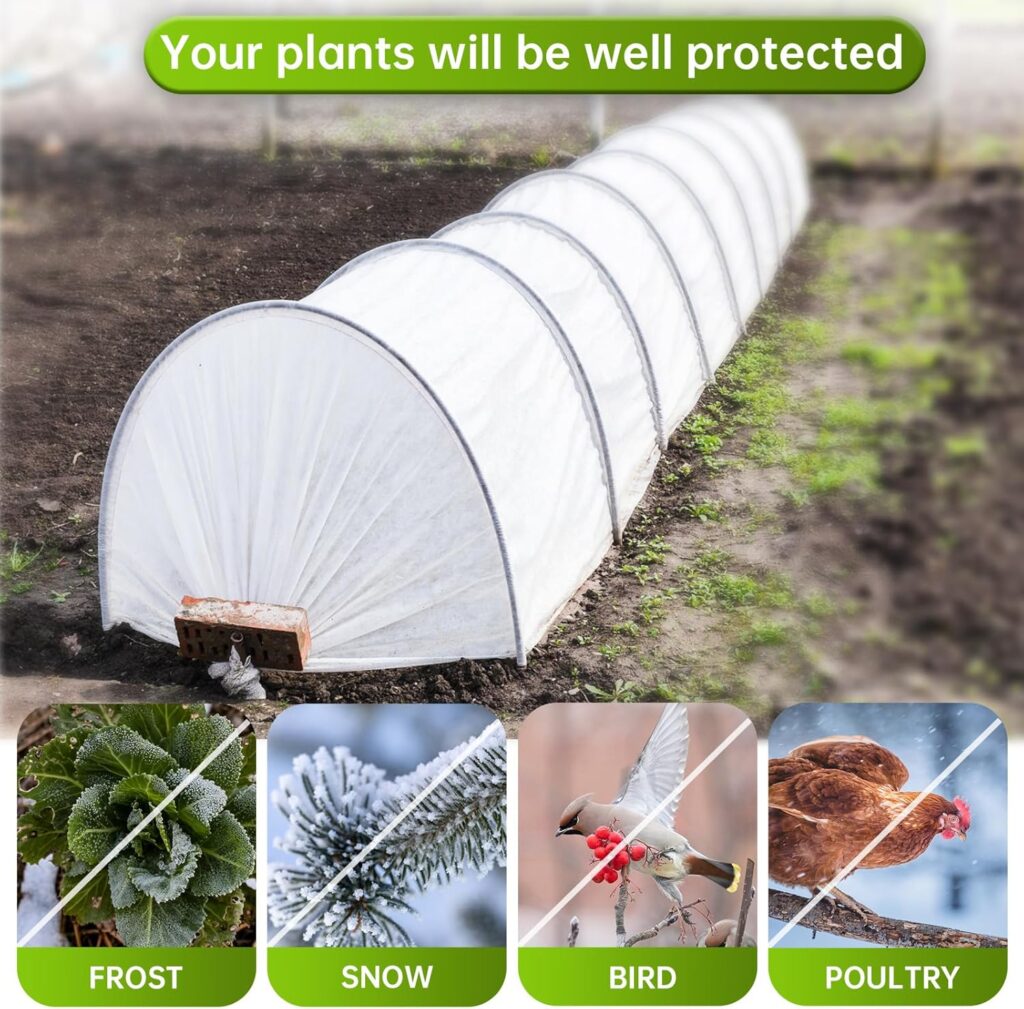
These thicker 1.05 oz/yd² frost cloth plant covers are made from upgraded non-woven fabric that combines strong insulation with good breathability. They help protect outdoor plants from cold, frost, snow, and strong winds while still allowing air, light, and moisture to reach the foliage.
Why choose these frost cloth plant covers?
-
Thicker 1.05 oz/yd² non-woven fabric for stronger freeze protection
-
4-pack of large covers, each 10 ft x 33 ft, for flexible coverage
-
Easy to cut and shape for beds, shrubs, and small trees
-
Tear-resistant material with reinforced edges for multi-season use
-
Reusable, easy to rinse, air dry, and store
Main uses:
-
Protect flowers, vegetables, seedlings, and potted plants from frost and cold snaps
-
Shield plants from sunscald, insects, birds, and light rain
-
Cover large or multiple planting areas, including flower beds and vegetable patches
How to use:
-
Drape each frost blanket directly over plants or lay it over support hoops as a floating row cover.
-
Cut to size as needed to fit beds, shrubs, or small fruit trees.
-
Secure the edges with soil, stakes, or rocks to lock in warmth and prevent frost from getting underneath.
-
After use, rinse off dirt, let the covers air dry, then fold and store for the next season.
Sold By: Cahomo
Latest Rank: 4
Price Range: $7.99 – $48
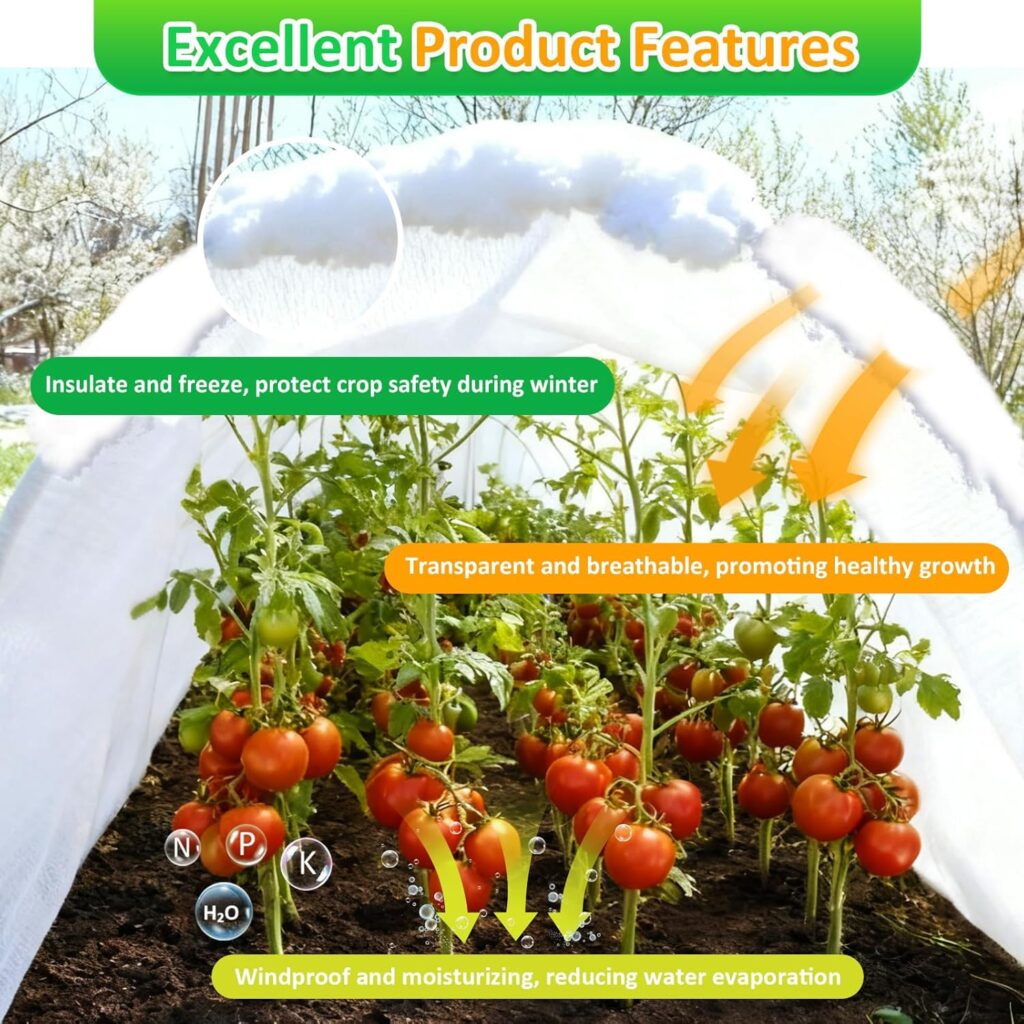
Why choose this weed barrier fabric?
Thick, non-woven construction for long-lasting performance
Heavy-duty design for high-traffic or demanding garden areas
Effective weed suppression without relying solely on chemicals
Suitable for both home gardens and professional landscaping
Main uses:
Under mulch or gravel in flower beds and borders
As ground cover in vegetable gardens and raised beds
Beneath pathways, patios, or decorative stone to prevent weed growth
Around trees and shrubs to reduce competition from weeds
How to use:
Clear the area of existing weeds, rocks, and debris.
Roll out the fabric over the prepared soil, overlapping edges where needed.
Cut X-shaped openings for plants or existing shrubs and trees.
Secure the fabric with landscape staples or garden pins.
Cover with mulch, gravel, or decorative stone for added protection and a finished look.
Sold By: Garutom LLC
Latest Rank: 3
Price Range: $15.19 – $26.39
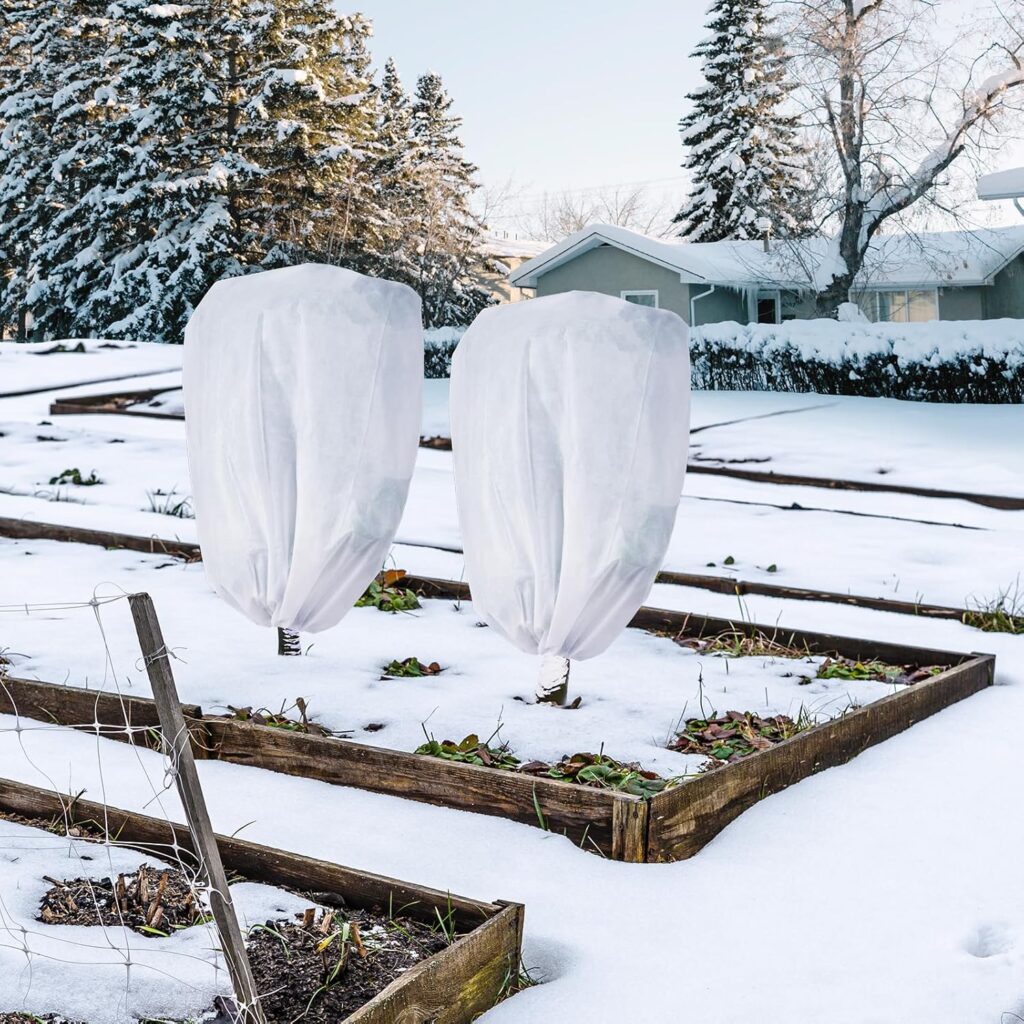
These Garutom plant jacket covers come in three sizes (42″ x 45″, 48″ x 72″, 78″ x 89″), so gardeners can choose the best fit for shrubs, small trees, and potted plants. For better freeze protection, it is recommended to choose a slightly larger cover.
Why choose these plant jacket covers?
Multiple sizes to fit a range of plants
Lightweight, breathable, anti-UV non-woven polypropylene (2.2 oz/sq. yard)
Transmits about 85% of available light while helping retain heat
Durable enough to protect against harsh weather, bugs, animals, and birds
Main uses:
Extend the growing season into early spring and late fall
Protect fruit trees, greenhouse plants, shrubs, and potted plants
Shield plants from frost, freeze, rain, snow, wind, and low temperatures in winter
Guard against strong sunlight, insects, and birds in spring and summer
How to use:
Slip the cover over the plant’s foliage.
Gently tighten the drawstring around the bottom to secure it.
On the largest size (78″ x 89″), use both the bottom drawstring and side zipper for easier access and a snug fit.
If the buyer is not satisfied with the plant cover, the brand offers responsive customer service and support.
Sold By: MIXC Direct
Latest Rank: 2
Price Range: $16.99 – $45.98
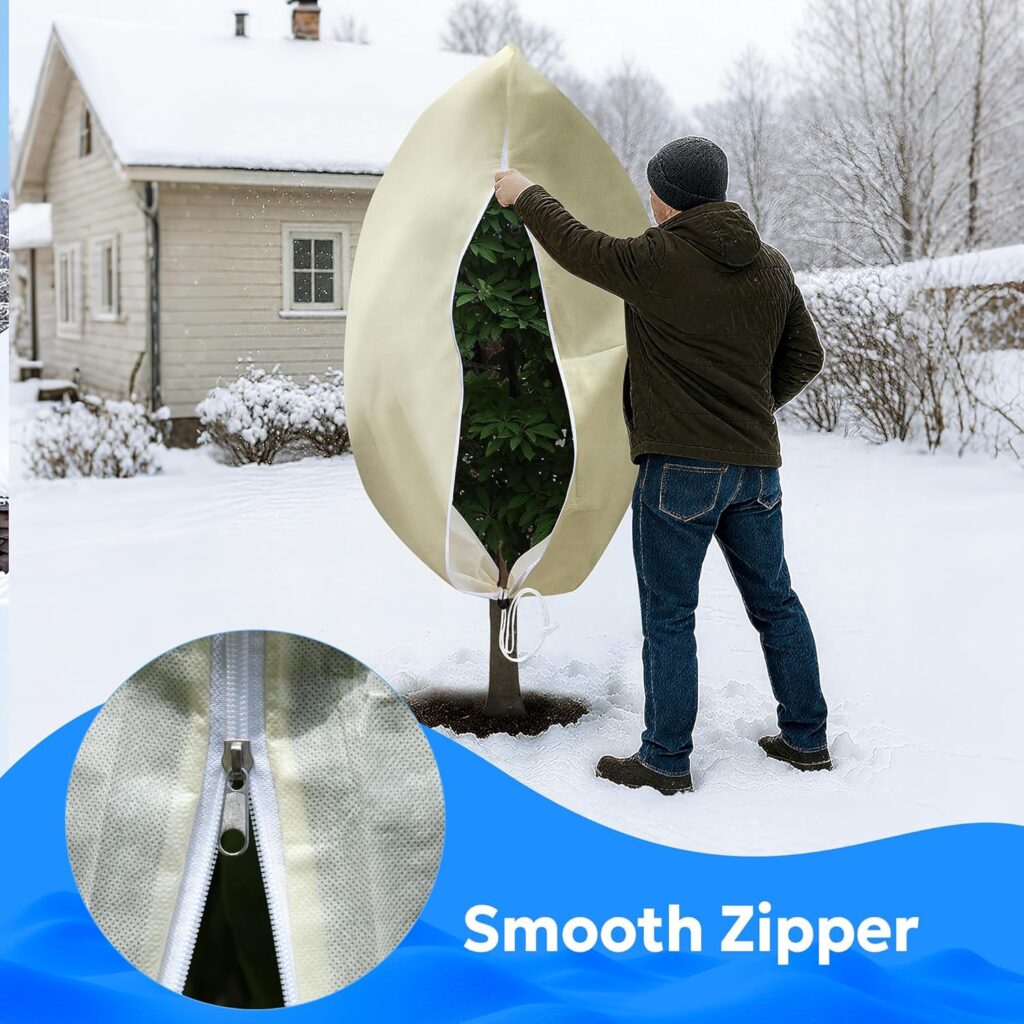
These large plant covers fit plants approximately 55–70 inches high and 84–94 inches around. They use heavy-weight FRC (1.77 oz/sq.yd) to extend the growing season in spring and fall, with about 40–60% light transmission and roughly 3–8 °F of freeze protection.
Why choose these large plant covers?
-
Sized for medium to large shrubs and small trees
-
Heavy-weight fabric for better frost protection
-
High-quality non-woven material that allows air and moisture through
-
Lightweight, soft, and plant-friendly
Main uses:
-
Protect plants from frost, snow, and hail in winter
-
Shield plants from insects and birds during the growing season
-
Maintain a breathable microclimate without harming growth
How to use:
-
Slip the cover over the plant, ensuring it reaches the ground.
-
Tighten the sturdy drawstring at the opening for a secure fit in harsh weather.
-
Leave the cover in place during cold spells; there is no need to remove it each morning and replace it each evening.
Sold By: Valibe
Latest Rank: 1
Price Range: $15.99 – $52.99
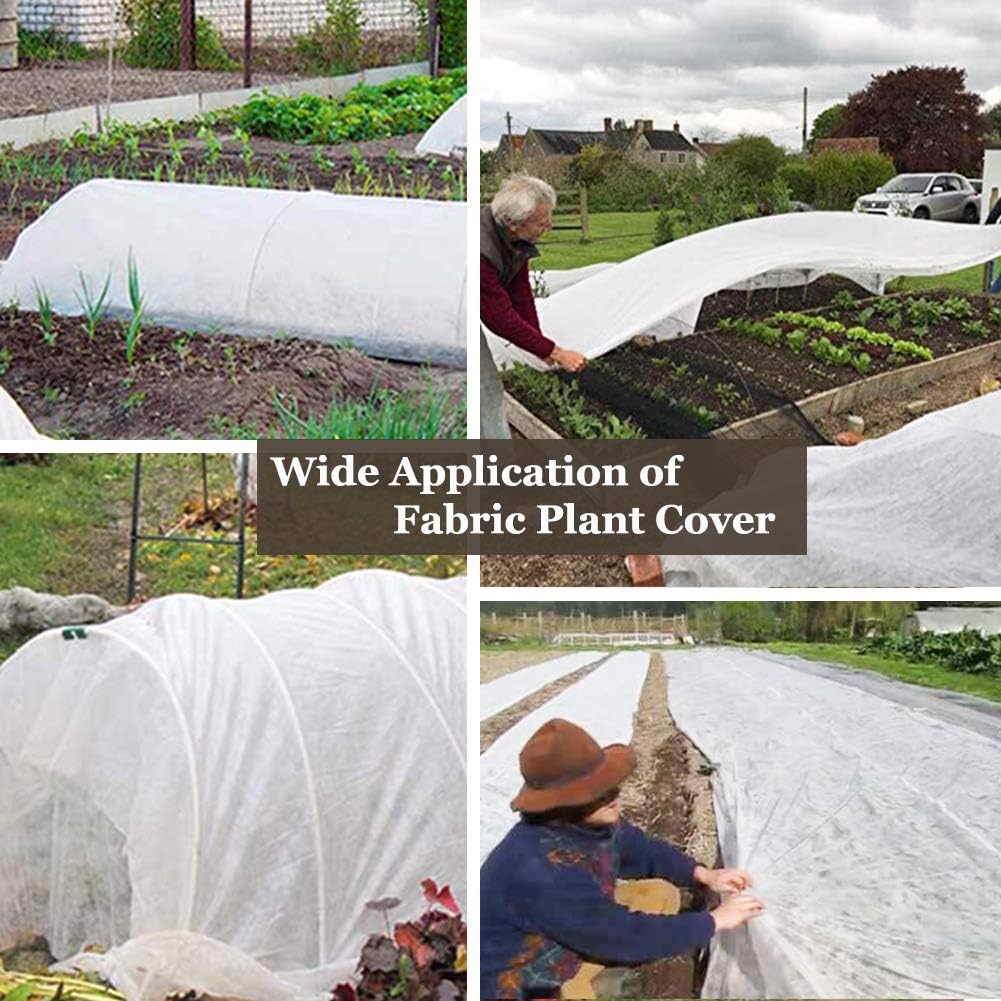
These 10×30 ft / 10×20 ft / 10×10 ft winter plant protection covers are made from 0.9 oz/sq.ft polypropylene frost fabric. They help protect plants from cold, wind, and animals, and can also reduce sun intensity.
Why choose these plant covers for freeze protection?
-
Cover up to 300 sq.ft of bushes or beds
-
Durable, reusable polypropylene floating row cover
-
Suitable for frost, sun, and light animal protection
Main uses:
-
Protect plants from cold and wind
-
Filter strong sunlight
-
Help prevent soil and plants from overheating
How to use:
-
Drape the cover directly over garden plants, or
-
Support it with hoops or a simple wooden frame.
-
Secure the edges with soil, rocks, or earth staples.
When to use frost covers:
-
Put covers on before sunset to trap ground heat that will radiate under the fabric overnight.
-
Remove covers the next day once temperatures rise above freezing so sunlight can warm the soil again.
-
Allow covers to dry before reusing.
-
For severe cold, multiple layers of cover can be used.
FAQs About Plant Covers and Freeze Protection
Do plant covers really work, or is it a myth?
Yes, they work when used correctly. Covers trap some of the heat that radiates from the soil at night, prevent frost from settling directly on leaves, and reduce wind chill. Even a few degrees of extra warmth can be the difference between damaged and healthy plants.
How many degrees of protection can I expect from frost cloth?
Medium-weight frost cloth made from polypropylene or polyester often gives about 2 to 4 degrees Celsius of protection, sometimes more, depending on conditions. Some sources describe 4 to 8 degrees Fahrenheit of added protection. Thicker fabrics tend to protect more but block more light.
Can I leave covers on all day?
-
Non-breathable covers, such as plastic or thick blankets, should be removed once temperatures rise above freezing and the sun comes out to prevent overheating and moisture buildup.
-
Breathable frost cloth can sometimes stay on during a series of cold days, but many gardeners still lift or vent it during the warmest hours so plants get sunlight and air circulation.
Is plastic OK to use?
Plastic can work as a short-term cover if it is supported above the foliage and the edges are sealed to the ground. Never let plastic rest directly on leaves. Remove it in the morning once temperatures rise. Breathable fabric is a safer and more forgiving choice for repeated use.
What about using old sheets or blankets?
They are fine for emergency protection. Sheets, blankets, burlap, and tarps are commonly suggested for short cold snaps. For repeated freezes or if you do a lot of season extension, a purpose made frost cloth is easier to handle, lighter, and often more effective.
Do I need to water before a freeze?
Yes, if the soil is dry. Moist soil holds more heat than dry soil and can release that heat under the cover during the night. Just avoid soaking the foliage late in the day so leaves have time to dry before the temperature drops.
Can plant covers protect from snow and wind, too?
Yes. Frost blankets and covers can help protect plants from wind damage, reduce water loss from leaves, and provide a more stable microclimate. Some gardeners find they also reduce pest damage.
Are plant covers reusable?
Most commercial frost cloths and plant jackets are designed to be reused for several seasons if you:
-
Shake off the snow gently
-
Allow them to dry before storage
-
Fold and store them in a dry, rodent-proof place
How do I protect container plants?
Container plants are more vulnerable because their roots are above ground. Bring them indoors or into a garage if possible. If they must stay outside, group them, wrap pots with bubble wrap or burlap, and then cover the whole group with frost cloth or blankets.
With the right combination of plant covers, good timing, and a few extra tricks like mulching and watering, you can help your plants shrug off many cold nights. \
